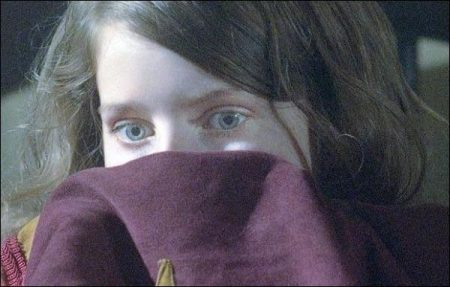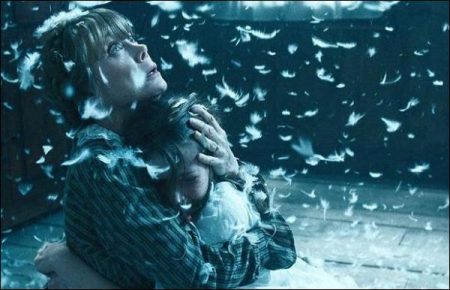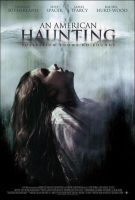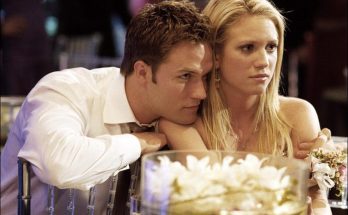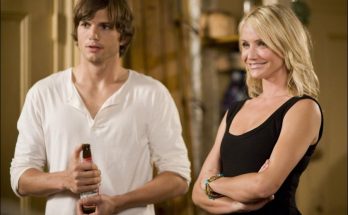Tagline: Possession knows no sounds.
Based on “The Bell Witch: An American Haunting” by Brent Monahan. Known throughout Tennessee as “Old Kate,” the Bell Witch took up residence with John Bell’s family in 1818. It was a cruel and noisy spirit, given to rapping and gnawing sounds before it found its voices. With these voices and its supernatural acts, the Bell Witch tormented the Bell family. This extraordinary book recounts the only documented case in U.S. history when a spirit actually caused a man’s death.
The local schoolteacher, Richard Powell, witnessed the strange events and recorded them for his daughter. Members of the Bell family have previously provided information on this fascinating case, but this book recounts the tale with novelistic vigor and verve. It is truly chilling.
Starring Academy Award winner Sissy Spacek (“Carrie”), Golden Globe winner Donald Sutherland (“Don’t Look Now”), Rachel Hurd-Wood (Wendy Darling in P.J. Hogan’s “Peter Pan” and the upcoming “Perfume: The Story of a Murderer”), and James D’Arcy (“Master and Commander: The Far Side of the World”), this story is based on true events validated by the State of Tennessee as the only case in U.S. history where a spirit or entity caused the death of a human being. With over 20 books written on the subject, and a town that still lives in fear of the return of the unseen spirit, the story of An American Haunting is terrifying.
Between the years 1818-1820, the Bell Family of Red River, Tennessee was visited by an unknown presence that haunted the family and eventually ended up causing the death of one its members.
Starting with small sounds around the farm, and the sighting of a strange creature with piercing yellow eyes, the sounds escalated into full brutal contact with certain family members, causing psychological and physical torment. The attacks grew in strength, with the spirit slapping, pulling, dragging, and beating the Bell’s youngest daughter, Betsy.
The Bells searched for rational explanations and ways to rid their house of this entity, but to no avail as the spirit began to communicate with them through sounds, and eventually multiple voices that sounded like the wind.
Fearing that the haunting was caused by a local woman — branded a witch — who had put a curse upon the family as a result of a land dispute, the Bells tried desperately to find ways of getting rid of the woman’s curse, yet the attacks and disturbances only escalated.
It was not until a personal journal of the matriarch of the Bell family, Lucy, was inadvertently discovered — along with Betsy’s doll — generations later in the attic of one of their descendants that the horrifying and shocking answer to what caused the haunting would finally be unveiled … along with the realization that the horror was still being visited on the family heirs.
About the Production
Something terrifying happened to the Bell family of Red River, Tennessee, nearly 200 years ago. Those horrifying occurrences in and around their home have been recounted by numerous scholars and paranormal experts, making it the most documented haunting in American history. It is, to date, the only case ever recorded in the United States where a spirit caused the death of a human being, and it remains to this day an unsolved mystery… Until now.
Ascending filmmaker Courtney Solomon writes, produces and directs a shocking vision of one family’s battle against forces of the dark—and their struggle to illuminate secrets that threaten to destroy them all—in the chilling psychological horror film AN AMERICAN HAUNTING…a project that recalls some of the cinema’s memorable explorations of encounters between the seen and unseen worlds, such as the 1960’s “Carnival of Souls” and “The Haunting” and the 1970’s “The Exorcist.”
“The time has finally come to tell you the truth of our family’s dark secret and the horrors you suffered as a young girl…”
For filmmaker Solomon, the dark side has always held a fascination. The up-andcoming director chose for the subject of his second feature film a story that had literally been haunting listeners and readers for two centuries—the tale of the “Bell Witch.” But rather than just retelling the story of the Bells as handed down through record and legend, Solomon (as triple hat wearer writer / director / producer) turned to a book by respected horror novelist Brent Monahan entitled The Bell Witch: An American Haunting.
Solomon was determined to incorporate validated accounts of what took place in the Bell home and dovetail those with the treatise presented by Monahan as being the root cause of the paranormal activity that tortured Betsy Bell and her family…in short, to end up with a plausible reality and one that offers a compelling story with a surprising and shocking twist.
Solomon offers, “There are certain aspects of the screenplay that do follow the original legend itself, which I felt was important to try to stay true to, because it’s historically documented, and there are many people that take it seriously. As far as the ending and what happens to Betsy Bell, that was something that was unique to the book and the author of the book, Brent Monahan. He had come up with that, and it was something that I felt was a believable cause—because essentially, it is an unsolved mystery. Our film is really one version, one representation, of what may have been the cause of that mystery.”
The haunting visited upon the Bells is customarily referred to as poltergeist activity—epitomized by noises, the moving of objects and the often violent assaults on those present. The possible core reason for the family’s trauma—as put forth by Monahan and Solomon—is supported by Dr. Nandor Fodor, a lawyer and journalist who dedicated his life to the study of psychic phenomenon in the mid-20th Century. Fodor once theorized that poltergeist activity was directly related to the personal problems of the subject at the center of the “haunting.” Others believe that poltergeists are the directed energy originating in a person’s mind—often an adolescent girl’s—brought about by some type of emotional or psychological trauma. All of these theories would point to Betsy as the origin of the haunting and support the plausible reality created in the film.
But as the Bell Witch was never seen by any eyewitness (only its effects), how would a filmmaker go about telling the story? Solomon continues, “It was very difficult to create the entity—to me, that was at the core of the whole movie. How you create something, a new way of showing a spirit, a part of someone’s soul that you don’t see—I felt just from my own experience, watching movies of this nature, I hate when they show it to you. It is always better in my imagination. And so I didn’t want to show it to the audience, but instead I wanted the audience to be able to see through its eyes.”
Also key to AN AMERICAN HAUNTING—prior to the on-set effects and camera work charged with creating the entity—lay in the casting. In that arena, Solomon and his filmmaking team scored with an enviable ensemble of American and British actors, headlined by two acclaimed and award-winning performers who themselves are no strangers to the genre of psychological horror: Donald Sutherland and Sissy Spacek.
Sutherland starred in the once shocking (as much for its frightening story as for its candid sexuality between the leads) and now classic “Don’t Look Now,” based on the story by Daphne du Maurier and directed by iconoclast Nicolas Roeg. Spacek played the title role in the motion picture adaptation of horror master Stephen King’s novel, “Carrie,” which was directed by Brian De Palma; Carrie White has since perhaps become one of the genre’s most remembered characters. For both actors, however, choosing a role is a simple matter of interest, being drawn to a character they feel compelled to bring to life…genre notwithstanding.
Sutherland says, “Obsession and redemption and guilt and self-chastisement— they’re interesting things to explore. And since they’re so much a part of the secret lives of so many people, particularly in this country, it’s interesting to expose them. I liked Courtney a lot, and he was open to working on the script, because it had come from the book and was in transition. Sissy and I enjoyed collaborating and worked with Courtney in a very positive way.”
Spacek explains, “My character is a woman who lived in the 1820s and is a mother of four. She’s just an ordinary woman who faces extraordinary circumstances, which is something I always find interesting in a character…and these were very extraordinary circumstances. Plus, it’s an intriguing story, because it’s very well documented, about a family who was haunted—there’ve been many books written about it. You can actually go and look it up in the state records where it took place. I think Courtney Solomon—who’s a huge fan of Hitchcock and Steven Spielberg—has really approached it in a very interesting and clever cinematic way.”
For the young actress cast in the pivotal role of Betsy Bell, it was the story that hooked her from the start. Rachel Hurd-Wood had recently starred in P.J. Hogan’s liveaction version of “Peter Pan,” and her portrayal of Wendy—a girl in transition from the naïveté of girlhood to the awakening of young adulthood—brought her critical and popular attention. It was this quality that Solomon and his team also felt was key to the character of Betsy. (Additionally, several were struck by the resemblance between Hurd-Wood and another actress when she was just starting out in Hollywood—the young Spacek—and felt their work together presented a figurative “passing of the torch.”)
Solomon remembers, “From the very first time I met Rachel, physically, she was my vision of Betsy as I’d always imagined her. She’d just done ‘Peter Pan,’ and the very first time we met, she babbled a lot—it was darling, it was funny. But there was just something about her that I thought, ‘She’s perfect for this.’ But I want to see if she was going to be able to work, if she was going to be able to do the work and go where Betsy needs to go. So I put her through a pretty rigorous process before I actually said, ‘Yes.’ And then every time, she would not let me down. She would come back, and she would be better. She’s really a raw talent.”
It was the darker aspects of playing Betsy—and the revelation of the key to the haunting—that intrigued Hurd-Wood. She comments, “After ‘Peter Pan,’ I had indeed read many scripts—they were good, they were fine. But as soon as I read AN AMERICAN HAUNTING—it was a Saturday morning, and I had to get up and do something—but once I started, I couldn’t stop, I couldn’t put it down. I was hooked. I called my agent as soon as I finished reading it and said, ‘Please, please, please get me an audition for this, because I really, really, REALLY want to do it!’ I mean, it took me completely by surprise, the ending. I had no idea. It’s a shock and it was something that just made me think, ‘I would love to play this part.’ I had to do it.”
Along with actor Hurd-Wood, fellow British performer Thom Fell completed the cast of the major roles of the Bell family, stepping in as eldest son, John, Jr. Fell is a familiar presence on English television and has recently begun branching out into feature film work. Fell was duly impressed by the weight his cinematic little sister bore on her young shoulders and said, “She’s done an incredible job, considering that she’s 14 and the amount of focus and dedication she’s got is really admirable. Some of that’s down to Courtney, I think—he’s really done a good job of keeping her there.”
An American Haunting (2006)
Directed by: Courtney Solomon
Starring: Donald Sutherland, Sissy Spacek, Rachel Hurd-Wood, James D’Arcy, Thom Fell, Gaye Brown, Vernon Dobtcheff, Philip Hurd-Wood, Zoe Thorne, Sam Alexander, Shauna Shim
Screenplay by: Courtney Solomon
Production Design by: Humphrey Jaeger
Cinematography by: Adrian Biddle
Film Editing by: Richard Comeau
Costume Design by: Jane Petrie
Music by: Caine Davidson
MPAA Rating: PG-13 for intense terror sequences, thematic material
Studio: Freestyle Releasing
Release Date: May 5, 2006
Visits: 275
